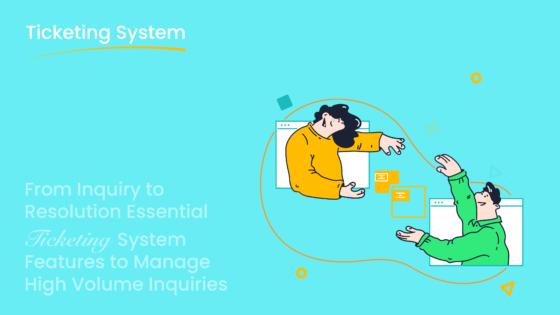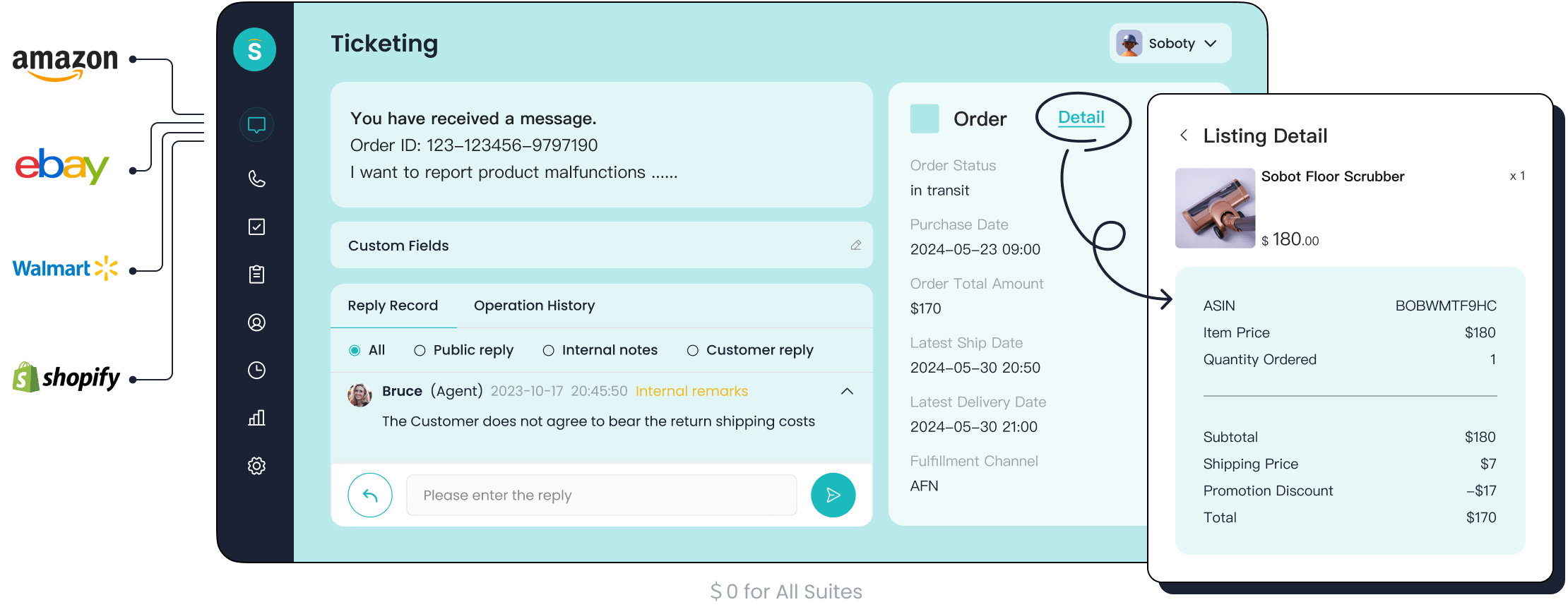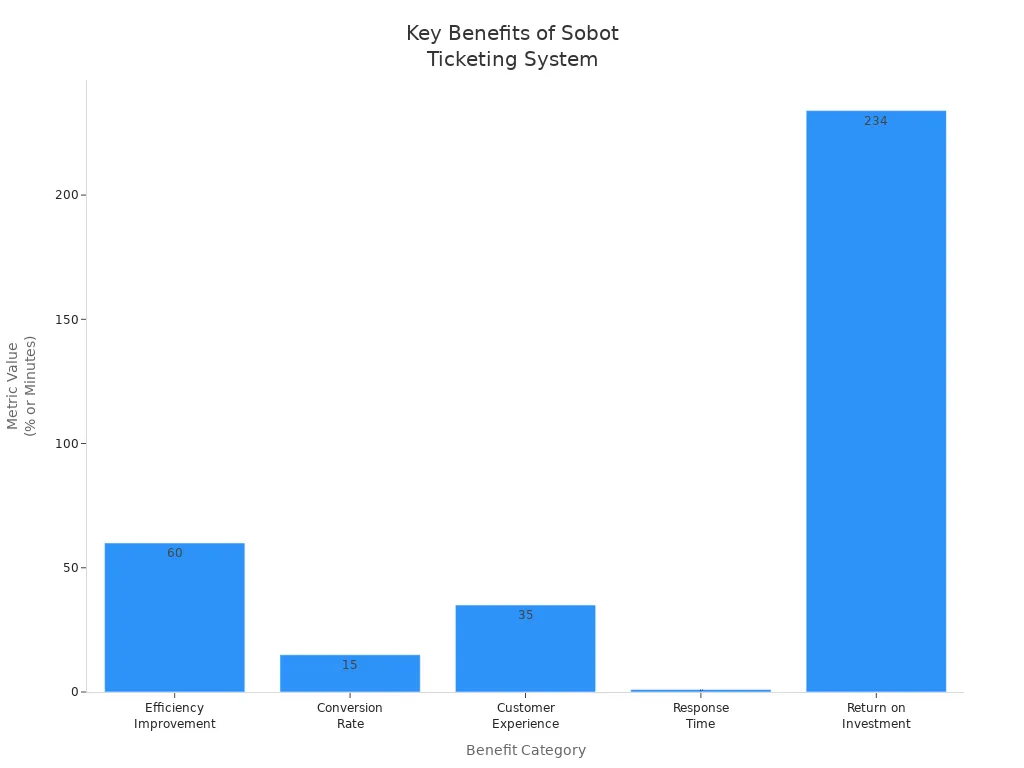Ticketing definition makes business life easier for everyone

A ticketing system transforms your customer service by making every interaction clear and organized. When you use Sobot or Sobot AI, you see faster first response times and higher customer satisfaction. Automation in Sobot call center solutions reduces manual work, letting your team focus on complex issues. Businesses benefit from improved efficiency, accurate ticket routing, and easy access to customer history. With a clear ticketing definition, you can track every request, boost employee productivity, and support your business growth.
Ticketing Definition

What Is a Ticketing System?
You may wonder what the ticketing definition means in a business context. A ticketing system is software that helps you manage and track support requests by turning every inquiry into a "ticket." This ticket acts as a digital record, capturing all details about the issue, the customer, and the steps taken to resolve it. The ticketing definition covers more than just logging problems. It includes organizing, prioritizing, and tracking each request from start to finish.
A modern support ticket system, like Sobot’s, lets you handle requests from email, chat, or even e-commerce platforms in one place. You can assign tickets to the right team members, set deadlines, and monitor progress. This approach keeps your customer service organized and ensures no request slips through the cracks. With features like automation, dashboards, and analytics, you gain real-time insights and improve your workflow. The ticketing definition also includes tools for collaboration, so your team can work together to solve issues faster.
Tip: Using a ticketing system helps you reduce response times and prevent missed issues, which boosts customer satisfaction.
Role in Customer Support
The ticketing definition plays a key role in customer support. You rely on a support ticket system to transform scattered customer inquiries into a structured process. This system automates ticket assignment, prioritization, and status updates, saving your team valuable time every day. For example, Sobot’s ticketing system uses AI to route tickets to the most suitable agent, increasing first contact resolution rates.
A ticketing system acts as the backbone of your customer service operations. It centralizes all requests, making it easier to manage high volumes without hiring more staff. According to industry data, companies often have only one IT worker for every 27 employees, so a ticketing system is essential for handling the workload efficiently. With self-service portals and automated responses, you empower customers to find answers on their own, reducing the number of tickets by up to 60%. This structured approach improves service quality and lowers costs, making the ticketing definition vital for any business focused on excellent customer support.
| Aspect | AI Ticketing Systems | Traditional Help Desks |
|---|---|---|
| Initial Investment | Upfront software and training costs | Lower software costs, higher ongoing expenses |
| Operational Costs | Lower over time, less manual work | Higher due to staff and infrastructure |
| Scalability | Easily handles more tickets | Scaling means hiring more staff |
| Long-term Value | More cost-effective, fewer salary expenses | More expensive to maintain |
Centralized Communication
Unified Channels
You often face customer questions from many places—email, chat, voicemail, and e-commerce platforms. Managing these separately can slow your team and cause mistakes. A ticketing system solves this by bringing all channels together in one workspace. You see every message in a single view, so you never miss a request. This unified approach helps you organize tickets by priority and subject, making it easier to respond quickly.
When you use a support ticket system, you can group similar issues and handle them together. This saves time and reduces errors. Automation tools, like auto-responders and canned replies, give customers instant answers and let your agents focus on complex problems. You also get a centralized knowledge base, so your team can find answers fast and keep responses consistent. Self-service options, such as FAQs and chatbots, help customers solve simple problems on their own. This lowers ticket volume and lets your team work on urgent cases.
Note: Centralized dashboards help you avoid duplicate tickets and repeated information, which improves both speed and accuracy.

Sobot Ticketing System Integration
Sobot’s ticket management system stands out by connecting all your communication channels. You can manage email, chat, voicemail, and even Shopify orders in one place. This integration gives your agents a complete view of each customer’s history, including past issues and purchases. You deliver faster, more personal service because you have all the details at your fingertips.
With Sobot, you boost interdepartmental collaboration. Teams can share notes, assign tickets, and update statuses in real time. The ticketing system supports a centralized knowledge base, so everyone uses the same information. This reduces confusion and keeps your service consistent. Analytics tools in the ticket management system show you trends and help you make better decisions. You improve customer satisfaction and loyalty by responding faster and more accurately.
- Centralized communication increases efficiency and productivity.
- You reduce agent stress and prevent lost inquiries.
- Integrated analytics help you track performance and improve your support ticket system.
Accountability and Transparency
Ticket Tracking
You need clear tracking to ensure accountability in your support team. When you use a ticketing system like Sobot, you can follow every ticket from start to finish. This tracking gives you a real-time view of each request, so nothing gets lost. You see who is working on a ticket, what steps have been taken, and when the next action is due. This level of tracking supports operational efficiency and helps you spot bottlenecks in your process.
- Ticket tracking systems let you set and automate Service Level Agreements (SLAs). These SLAs define clear deadlines and expectations, which increases accountability.
- Automated SLA alerts notify your team when deadlines approach, so you never miss a resolution.
- You can track key performance indicators such as ticket resolution rate, customer satisfaction scores, and tickets closed per agent. This data helps you monitor both individual and team performance.
- Ticket quality rubrics give you objective standards for evaluating agent responses, supporting consistent accountability.
- Real-time data from ticket tracking software helps you make data-driven decisions and improve your process.
- Centralized collaboration on tickets reduces miscommunication and speeds up resolution, holding teams accountable across departments.
Tracking also helps you identify which agents meet or miss performance goals. By measuring tickets closed per agent, you can recognize top performers and provide extra training where needed. When you use Sobot, you get detailed analytics and smart notifications that keep your team on track and boost operational efficiency.
Tip: Consistent tracking leads to faster ticket resolution and higher customer satisfaction.
Assignment and Resolution
Transparent assignment and resolution build trust with your customers. When you assign tickets based on your team’s skills and expertise, you ensure quick and accurate resolution. Sobot’s system automatically routes tickets to the right agent, which improves efficiency and speeds up the resolution process.
- Transparent assignment ensures that each ticket goes to the best person for the job, leading to faster and more accurate resolution.
- Clear communication about ticket status and expected resolution times keeps your customers informed and valued.
- Documenting solutions after resolution helps you build a knowledge base and shows your commitment to accountability.
- Asking for customer feedback before closing tickets supports continuous improvement and strengthens relationships.
- Efficient ticket management prevents issues from being overlooked, which enhances the overall customer experience and loyalty.
You can use Sobot’s ticket tracking features to keep everyone updated on the status of each ticket. Customers appreciate knowing when to expect a resolution. Your team benefits from clear guidelines and automated reminders, which drive operational efficiency. When you focus on transparent assignment and resolution, you create a support process that customers trust.
Note: A strong ticket tracking and resolution process not only improves efficiency but also supports long-term customer loyalty.
Efficiency and Automation

Workflow Automation
You want your support team to work smarter, not harder. Workflow automation in a ticketing system like Sobot’s helps you achieve this goal. When you automate repetitive tasks, you free your agents from manual work. For example, Sobot can automatically create tickets from emails, chats, or voicemails. The system then routes each ticket to the right agent based on custom rules. This means your team spends less time sorting and more time solving customer problems.
A large BPO organization with over 60,000 agents saw a 40% reduction in manual workload after using automated workflows. This kind of automation removes repetitive steps from your process, so your team can focus on complex issues that need human attention. You see fewer mistakes and faster ticket handling. As a result, you boost both efficiency and productivity across your support operation.
Tip: Automated workflows help you handle high ticket volumes during busy periods without hiring more staff.
You also gain better visibility into your process. Sobot’s dashboard shows you where tickets are in the workflow, who is working on them, and what actions are next. This transparency supports increased operational efficiency and helps you spot bottlenecks quickly.
SLA Management
Service Level Agreements (SLAs) set clear expectations for your team and your customers. With Sobot, you can define response and resolution times for different types of tickets. The system tracks these SLAs automatically, sending reminders to agents when deadlines approach. This keeps everyone accountable and ensures you meet customer expectations.
SLAs do more than just set targets. They help you organize your workflow, prioritize urgent tickets, and allocate resources where they are needed most. When you manage SLAs well, you improve customer satisfaction and increase operational efficiency. In fact, 52% of customers expect answers within an hour, so meeting these targets builds trust and loyalty.
Here is a table showing the measurable benefits of SLA management in ticketing systems:
| Measurable Benefit | Explanation |
|---|---|
| Improved Customer Satisfaction | SLAs ensure quicker responses and resolutions, meeting customer expectations. |
| Enhanced Operational Efficiency | SLAs simplify workflows, reduce response times, and optimize resource allocation. |
| Significant Cost Reduction | Prioritizing critical issues with SLAs leads to reduced handling time and cost savings. |
| Increased Transparency & Accountability | Clearly defined roles and expectations build trust and set accountability between support teams and customers. |
| Competitive Advantage | Companies with strong SLA management achieve higher revenue growth by delivering superior customer service. |
| Data-Driven Goal Setting | SLAs help set business targets based on team performance and customer expectations. |
| Consistent Support Standards | SLAs ensure uniform quality of service across all agents. |
| Managing Customer Expectations | Customizable SLAs help meet diverse customer needs and scenarios. |
| Identifying Performance Gaps | Tracking SLA compliance highlights areas for improvement in support operations. |
| Enhanced Marketing Strategy | Brands use SLA commitments to attract and retain customers. |
You can set up real-time monitoring with dashboards and alerts in Sobot. This helps you track SLA compliance and take action if a ticket is at risk of missing its deadline. You also empower your agents with training and feedback, so they can meet or exceed SLA targets. Automation in SLA management means you spend less time tracking and more time delivering great service.
Sobot’s AI Features
Artificial intelligence takes your ticketing system to the next level. Sobot’s AI features automate ticket logging, categorization, and routing. The system uses natural language processing to understand customer issues and send tickets to the right team. This reduces response times and improves accuracy.
AI in Sobot also prioritizes tickets by urgency and complexity. The system suggests best responses and can even resolve common questions automatically. This boosts productivity and ensures your team focuses on the most important tasks. You see fewer errors because AI maintains a consistent brand voice and tone.
Here are some ways AI features in Sobot improve your support process:
- AI-powered ticket routing assigns tickets based on agent expertise, availability, and customer sentiment.
- The system suggests relevant knowledge base articles and recommended responses, speeding up resolution times.
- AI chatbots handle routine inquiries, reducing the number of tickets that need human intervention by up to 50%.
- Predictive analytics forecast staffing needs, helping you allocate resources and maintain service levels.
- Automated quality assurance checks ensure consistent service quality and reduce manual review workload.
- AI tools help you scale support during peak times without sacrificing quality or increasing costs.
| Feature/Aspect | Impact on Ticket Resolution Time and Quality |
|---|---|
| AI-powered ticket routing (NLP, ML) | Improves first-call resolution rates by up to 30%, increases routing accuracy |
| Reduction of human error | Cuts errors by up to 75%, leading to more accurate and faster resolutions |
| AI chatbots and self-service options | Resolve routine inquiries rapidly, reducing tickets needing human intervention by up to 50% |
| Automation benefits | Reduces agent workload, allowing focus on complex issues, enhancing speed and quality |
| Workflow integration | Streamlines processes, contributing to faster and more efficient ticket handling |
You benefit from 24/7 support, as AI never sleeps. Customers get immediate answers, which increases satisfaction. Real-time insights and predictive analytics help you optimize staffing and workflows. This leads to higher productivity and better customer experiences.
Note: According to the Zendesk Customer Experience Trends Report, 51% of consumers prefer bots for immediate assistance. AI-driven automation meets this demand and helps your business stand out.
Sobot’s AI features support omnichannel integration, so you deliver seamless support across voice, chat, and email. You can handle high ticket volumes, maintain quality, and keep your team focused on what matters most. Automation, combined with AI, transforms your support process and drives efficiency at every step.
Customer Support Experience
Faster Responses
You want every customer service interaction to feel quick and easy. Fast responses show your customers that you value their time. When you use a modern ticketing system like Sobot, you can automate ticket routing and categorization. This means your team sees new requests right away and can start working on them without delay. Sobot’s AI features help you sort and prioritize tickets, so urgent issues get attention first. You reduce wait times and improve customer satisfaction with every resolved ticket.
Customers expect answers fast. Studies show that 52% of people want a response within an hour. If you meet this expectation, you build trust and loyalty. Sobot’s system sends instant notifications to agents when new tickets arrive. You can use canned responses for common questions, which speeds up the process even more. When your team handles tickets quickly, you see higher customer satisfaction scores and more positive feedback.
Faster responses also help you achieve first contact resolution. When you solve problems on the first try, you save time for both your team and your customers. Sobot’s unified workspace gives agents all the information they need, so they can answer questions without switching between systems. This leads to a better customer experience and improved customer satisfaction.
Tip: Quick responses and first contact resolution are key drivers of customer loyalty and repeat business.
Multilingual Support
You serve customers from many backgrounds. Language should never be a barrier to great customer support. Sobot’s ticketing system supports multiple languages, so you can help people in their native language. This feature is essential for global businesses that want to reach more customers and improve customer satisfaction.
The impact of multilingual support goes beyond simple translation. It builds trust and makes customers feel valued. When you offer support in a customer’s language, you reduce misunderstandings and speed up resolution. The following table shows how multilingual support affects customer satisfaction and loyalty across different industries:
| Evidence Type | Details |
|---|---|
| Statistical Evidence | - 70% of global consumers consider native language support essential. - 70% of end-users are more loyal to companies offering support in their native language. - 29% of businesses lost customers due to lack of multilingual support. |
| Case Study: Telecom | Spanish-speaking customer churn dropped by 22% within 6 months after implementing Spanish-language support. Customer satisfaction scores improved significantly. |
| Case Study: Financial | Chinese-speaking client retention rose by 35% after introducing multilingual support and translated documents. Referrals increased substantially. |
| Case Study: Retail | Spanish-speaking customers increased repeat purchases by 25%, and average order value rose by 18% after launching a Spanish-language e-commerce site and support. |
| Operational Benefits | Multilingual support reduces language barriers, improves communication efficiency, and decreases handling times and agent stress. |
| Strategic Impact | Multilingual support fosters trust, loyalty, and expands market reach, preventing revenue loss due to language friction. |
You can see that multilingual support leads to improved customer satisfaction and higher loyalty. Sobot’s system lets you translate tickets and responses automatically. Your agents can communicate clearly, no matter where your customers live. This reduces handling times and agent stress. You also open your business to new markets and prevent lost sales due to language issues.
Note: 70% of customers feel more loyal to companies that offer support in their native language. You can read more about the impact of language on customer loyalty in Harvard Business Review.
Satisfaction and Loyalty
You want every customer to feel satisfied after each interaction. Satisfaction is the foundation of loyalty and repeat business. When you use Sobot’s ticketing system, you give your team the tools to deliver excellent customer service every time. Automated workflows, AI-powered suggestions, and a unified workspace help your agents resolve issues quickly and accurately. This leads to improved customer satisfaction and a better overall customer experience.
Satisfied customers are more likely to return and recommend your business to others. Research shows that loyalty programs, personalized offers, and fast support all increase satisfaction and loyalty. When you provide quick resolutions and first contact resolution, you build trust. Customers who feel valued will visit your store more often and spend more.
Here are some ways improved ticketing processes drive satisfaction and loyalty:
- AI automates ticket categorization, routing, and prioritization, reducing manual effort and improving efficiency.
- Natural language processing helps agents resolve issues faster and more personally.
- AI-powered knowledge management supports agents with real-time resources, leading to faster resolution.
- Higher customer satisfaction is strongly linked to increased loyalty and repeat purchases.
- Positive customer service experiences increase the likelihood of customers purchasing more from your company.
Sobot’s analytics let you track customer satisfaction scores and see where you can improve. You can use this data to refine your processes and train your team. When you focus on satisfaction, you create loyal customers who support your business for years to come.
Callout: Improved customer satisfaction leads to higher Net Promoter Scores (NPS) and more repeat business. Sobot helps you achieve these results with every ticket.
Data and Insights
Analytics for Improvement
You need clear analytics to drive improvement in your customer support. Sobot’s ticketing system gives you real-time insights into every part of your support process. You see ticket volumes, resolution times, and customer satisfaction scores as soon as they happen. This immediate access helps you spot trends and fix issues before they grow. Advanced ticketing systems like Sobot’s use automated reporting to show you where your team excels and where you can make changes for continuous improvement.
You can use these insights to make data-driven decisions. For example, if you notice a spike in ticket volume about a certain product, you can update your knowledge base or train your team. Regular analysis of key metrics—such as ticket tracking, resolution time, and user satisfaction—helps you find bottlenecks and improve your workflow. Sobot’s analytics also let you compare performance over time, so you can measure the impact of any changes you make.
Tip: Real-time insights help you solve problems quickly and keep your service quality high.
Performance Monitoring
Performance monitoring tools in Sobot’s ticketing system give you a clear view of your team’s work. You track important metrics like ticket volume, mean time to resolution, and first-contact resolution rates. These insights help you find delays or slowdowns in your process. You can filter data to pinpoint exactly where bottlenecks happen, whether it’s in routing, assignment, or escalation.
- Advanced reporting tools show you ticket volume, resolution times, and team performance.
- These metrics help you identify bottlenecks and optimize workflows.
- Sobot’s dashboards provide transparency and highlight areas for improvement.
- AI-powered systems detect patterns and automate routine tasks, so you can focus on critical issues.
You measure the return on investment (ROI) of your ticketing system by looking at time saved, customer satisfaction, and cost per interaction. Here’s a quick overview:
| Metric / Aspect | Value / Description |
|---|---|
| Daily Time Savings per Agent | 1.2 hours saved daily |
| Customer Satisfaction Increase | Up to 35% improvement |
| Reduction in Resolution Time | Up to 87% reduction |
| Cost per Interaction (AI vs Human) | $0.50 vs $6.00 per interaction |
| Average ROI | $3.50 return for every $1 invested |
You use these insights to set goals, train your team, and keep your support running smoothly. Tracking performance ensures you meet your targets and deliver great service every day.
Real-World Success
OPPO Case Study
You can see the impact of a powerful ticketing system by looking at OPPO’s experience. OPPO, a leader in smart devices, faced a surge in customer inquiries during peak shopping seasons. By adopting Sobot’s Ticketing System, OPPO transformed its support process. The system enabled OPPO to automate ticket assignment and streamline the resolution of customer issues. As a result, OPPO achieved an impressive 83% resolution rate. This means your team can resolve most customer requests quickly and efficiently. OPPO also saw a 94% positive customer feedback rate, showing that customers valued the fast and accurate resolution of their concerns. The company’s repurchase rate increased by 57%, proving that a strong focus on resolution leads to higher loyalty and repeat business. Sobot’s solution helped OPPO handle high volumes of tickets, maintain quality, and deliver consistent resolution across all channels.
When you prioritize resolution, you build trust and satisfaction with every customer interaction.
Industry Applications
Sobot’s Ticketing System delivers strong results in many industries. You can use the platform to improve resolution in retail, finance, e-commerce, and more. Here are some real-world examples:
- In the financial sector, Sobot’s billing and payment tracking tools led to a 35% productivity boost, fewer payment delays, and better resolution of billing issues.
- Retailers use Sobot’s multi-channel integration and AI chatbots to handle routine queries, saving time and ensuring quick resolution for customers.
- E-commerce businesses benefit from faster resolution times and improved customer communication, thanks to Sobot’s seamless integration with platforms like Shopify.
- Influencer marketing agencies use Sobot’s WhatsApp Business API integration to speed up customer support and achieve rapid resolution of inquiries.
- Sobot supports over 10,000 brands worldwide, providing reliable resolution and support through ticketing, chatbots, live chat, and voice solutions.
You can rely on Sobot to deliver consistent resolution and satisfaction, no matter your industry.
Choosing a Ticketing System
Key Features
When you choose a ticketing system, you want features that make your support process smooth and reliable. The right help desk software should help your business grow and adapt to new challenges. Here are the most important features to look for:
- Automation capabilities: Automate ticket routing, canned responses, and escalations to save time and reduce manual work.
- Customization options: Adjust ticket fields, priorities, and workflows to fit your business needs.
- Integrated knowledge base: Give customers and agents quick access to answers, lowering ticket volume.
- Comprehensive reporting and analytics: Use real-time dashboards and reports to track trends and improve service.
- SLA management: Set and monitor response times to keep your team on track.
- Collaboration tools: Share notes, assign tickets, and update statuses in real time.
- Mobile support: Manage tickets from anywhere with mobile apps.
- Integration with your tech stack: Connect with CRM, e-commerce, and communication tools for a seamless workflow.
You also need strong security, multi-language support, and 24/7 availability. Sobot’s ticketing system offers all these features, including AI-powered automation, multilingual support, and trusted analytics. This makes it a smart choice for any business looking to improve customer support.
Tip: Always check if the help desk software can scale as your business grows and if it supports easy integration with your current tools.
Fit for Your Business
You need a ticketing system that matches your business operations. Start by checking if the platform is cloud-based for flexibility and easy updates. Make sure the help desk software is simple for both agents and customers to use. Look for customization options that let you set up workflows and ticket categories that fit your team.
Assess if the system can handle your ticket volume as your business expands. Confirm that it supports automation for tasks like ticket assignment and escalation. Multi-channel support is key, so you can manage email, chat, and phone requests in one place. Sobot’s ticketing system integrates with popular platforms like Shopify and offers real-time dashboards to monitor performance.
Common challenges include integration issues and user adoption. You can overcome these by choosing a system with a user-friendly interface and strong support. Always review customer feedback and vendor reputation before making a decision. A good fit means your team works faster, your customers get better service, and your business stays ahead.
You gain real advantages when you choose Sobot’s ticketing system for customer service.
- You streamline customer support with omni-channel tools and automation.
- You improve satisfaction by resolving issues quickly and personally.
- You connect your business systems for seamless data flow and better customer service.
- You future-proof your business with scalable, AI-powered solutions.

To get started, define your goals, involve your team, and explore Sobot’s resources for a smooth customer service transformation.
FAQ
What is the main benefit of using a ticketing system like Sobot?
You gain a unified workspace for all customer requests. Sobot’s support ticket system automates ticket tracking, assignment, and resolution. This reduces manual work and improves response times. Businesses using Sobot report up to 87% faster ticket resolution.
How does ticket tracking improve customer support?
Ticket tracking lets you follow every request from start to finish. You see who handles each ticket and when actions occur. This process ensures no issue gets lost. Sobot’s ticketing definition includes real-time updates and smart notifications for better accountability.
Can Sobot’s ticketing system handle multiple languages?
Yes, Sobot’s support ticket system offers multilingual support. You can serve customers in their preferred language. This feature helps global businesses increase customer satisfaction and loyalty. Over 70% of users prefer support in their native language.
What channels can I integrate with Sobot’s ticketing system?
You can connect email, chat, voicemail, and e-commerce platforms like Shopify. Sobot’s ticketing definition covers seamless integration, so you manage all interactions in one place. This unified approach boosts efficiency and prevents missed requests.
How does Sobot help you meet Service Level Agreements (SLAs)?
Sobot’s ticketing system tracks SLAs automatically. You set response and resolution times for each ticket. The system sends reminders before deadlines. This helps you meet targets and maintain high customer satisfaction. SLA management is a key part of Sobot’s ticketing definition.
Tip: Use Sobot’s analytics to monitor SLA compliance and improve your support ticket system.
See Also
Understanding The Efficient Operation Of Call Center Automation
Round The Clock Live Chat Enhances Business Growth
Expert Techniques For Live Chat Success In Retail
